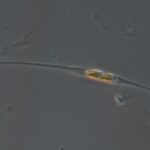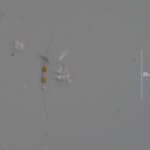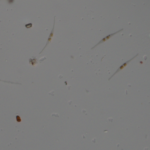Detected Species
-
HAB Species
- Diatoms
- Dinoflagellates
- Cyanobacteria
- Raphidophytes
- Haptophytes
-
Non-toxic Species
- Diatoms
- Dinoflagellates
Contact Us:
Mihaela D. Enache, Ph.D., Project Manager & Co-PI, Research Scientist I, Division of Science and Research, NJDEP (mihaela.enache@dep.nj.gov)
Ling Ren, Ph.D., PI, Research Assistant Professor, College of Science, George Mason University (lren2@gmu.edu)
Cylindrotheca closterium
Syn. Ceratoneis closterium
Morphology
Cells solitary and motile, yellow-brown in color, slightly curved or sigmoid. A nucleus and two chloroplasts located in the central region of the cell.
Toxins and toxicity
This species is not known to produce harmful toxins. However, its bloom can produce mucilage and foams, and lead to water discoloration and repellent smells, impacting coastal water quality and tourism.
Distribution and Occurrence
Meroplanktonic species, meaning it has both benthic and planktonic characteristics. It is a cosmopolitan species distributed worldwide, in marine, brackish, and freshwater environments. In this study, the species was common in all ponds in winter (December to January) and spring-summer (April to July), and highly abundant in spring.
References
Lassus P.; N. Chomérat, P. Hess, E. Nézan. 2016. Toxic and Harmful Microalgae of the World Ocean / Micro-algues toxiques et nuisibles de l’ocean mondial. Denmark, International Society for the Study of Harmful Algae / Intergovernmental Oceanographic Commission of UNESCO. IOC Manuals and Guides, 68. (Bilingual English/French)


